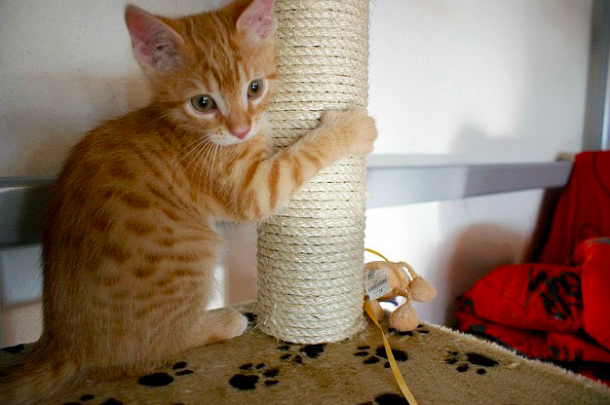
If you’re a cat lover like me, you’ve probably dealt with the problem of shredded furniture. Cats have to scratch as surely as birds have to fly, for reasons buried deep in their psyches, like marking territory, as well as for play, exercise, and nail conditioning.
However, rather than take a hatchet to a hangnail and remove kitty’s claws (and ligaments, muscle, and bone) in a cruel procedure called “declawing,” there are simple, non- invasive solutions to worries about the furnishings. Declawing involves 10 separate, very painful amputations. It is a serious surgery, not just a manicure. Declawing a cat involves general anaesthesia and amputation of the last joint of each toe, including the bones. After surgery, the nails may grow back inside the paw, causing pain but remaining invisible to you. Declawing results in a gradual weakening of leg, shoulder, and back muscles, and because of impaired balance caused by the procedure, declawed cats have to relearn to walk, much as a person would after losing his or her toes.
Many kind veterinarians will not perform the declawing surgery. As Dr. Nichols Dodman of the Tufts University School of Veterinary Medicine says, “Declawing is abhorrent and inhumane,” and as Dr. Louis J. Camuti, who has practiced veterinary medicine for 40 years, puts it, “I wouldn’t declaw a cat even if you paid me $ 1,000 a nail.”
The reasons not to declaw are too numerous to count on one paw. It can make cats who were once full of life lifeless, withdrawn, and upset, and you will not be able to turn back the clock. Cats naturally walk like ballerinas on their “pointe,” but declawing throws them off balance, forcing them to learn to walk in a very different way, which can cause irreparable and painful damage to the spine. Nearly two dozen countries— including England, Australia, and Japan— ban or severely restrict declawing surgeries.
It is the little hook on the end of your cat’s nails that is responsible for pulling threads and tearing at things, so that hook has to be worn down or snipped off . Here is how to avoid tatters while keeping your cat happy:
- Get as many scratching posts as you can (the horizontal ones work as well as the vertical), trying different surfaces and styles. Put catnip on them once in a while to make them super inviting.
- Smear a little cologne on any fabric area where you do not want your cat to scratch. Sometimes covering a piece of furniture temporarily with contact paper or something else that’s slippery will stop the behaviour.
- If you have a steady hand and good eyesight, buy a pair of cat nail clippers and use them. Gently squeeze each nail out, look for the quick (this is vital), and snip off the hook only, just above the quick. If you are unsure, go to a gentle veterinarian or groomer and insist on staying with your cat while his or her nails are clipped.
- Spay or neuter your cat! It reduces the need for them to mark their territory.
There you have it, friends.
Happy purring!
by: Jana Sevilla
Jana is a campaign coordinator for People for the Ethical Treatment of Animals (PETA) Asia.
To get involved with PETA’s work in the Philippines, please visit PETAAsiaPacific.com or email info@PETAAsiaPacific.com.

